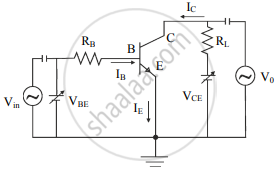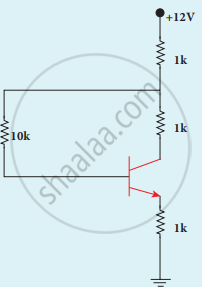Advertisements
Advertisements
Question
With the help of a neat circuit diagram, explain the transistor as an amplifier?
Solution
Working of an amplifier:
- The circuit of an amplifier using an n-p-n transistor in CE configuration is shown in the figure.

- When the input voltage Vin is not applied, applying the Kirchhoff’s law to the output loop, we can write, VCC = VCE + ICRL
- Similarly, for input loop,
VBB = VBE + IBRB - When the input AC signal is applied, Vin is not zero. Thus, the voltage drop across the input loop will now be,
VBB + Vin = VBE + IBRB + ΔIB (RB + ri) ....(1) - The AC signal applied adds the current of ΔIB to the original current flowing through the circuit. Therefore, the additional voltage drop in the input loop will be across resistor RB (= ΔIBRB) and across the input dynamic resistance of the transistor (= ΔIBri).
- From equation (1),
Vin = ΔIB (RB + ri)
As, RB is very small, we can consider,
Vin = ΔIBri - The changes in the base current IB cause changes in the collector current IC. This changes the voltage drop across the load resistance because VCC is constant. We can write,
ΔVCC = ΔVCE + RLIC = 0
∴ ΔVCE = -RLIC - The change in the output voltage ΔVCE is the output voltage Vo hence we can write,
Vo = ΔVCE = `beta`ACRLΔIB
APPEARS IN
RELATED QUESTIONS
Why is the base of a transistor made thin and is lightly doped?
In a transistor amplifier, IC = 5.5 mA , IE = 5.6 mA. The current amplification factor β is ______
With the help of a neat diagram, explain the working of the npn transistor?
The principle based on which a solar cell operates is ____________.
The light emitted in an LED is due to
Give the Barkhausen conditions for sustained oscillations.
What is rectification?
A transistor of α = 0.99 and VBE = 0.7 V is connected in the common-emitter configuration as shown in the figure. If the transistor is in the saturation region, find the value of collector current.

In a common emitter amplifier, the input resistance is 1000 Ω, the peak value of Input signal voltage is 5 mV, and β = 60. The peak value of output current is
The condition to convert an amplified signal into an oscillating signal is ______
For a transistor, the current ratio 'βdc' is defined as the ratio of ______.
In an npn transistor, the base current is 100 µA and the collector current is 10 mA. The emitter current is ______.
In an npn transistor, the collector current is 24 mA. If 80% of electrons reach collector, its base current in mA is ______.
In case of npn transistors, the collector current is always less than the emitter current because ______.
A pnp transistor is used in common-emitter mode. If a change of 40 µA in base current brings a change of 2 µA in collector current with 0.04 V in base-emitter voltage, then the input resistance is ____________.
In a transistor, doping level in base is increased slightly, the collector current and base current respectively ______.
In transistor amplifier, base-emitter junction is forward biased and collector emitter junction is reverse biased. The current gain is ______.
In the case of transistor, the relation between current ratios αdc and βdc is ______.
For an ideal diode, the current in the following arrangement is ______.

In common emitter amplifier, a change of 0.2 mA in the base current causes a change of 5 mA in the collector current. If input resistance is 2K `Omega` and voltage gain is 75, the load resistance used in the circuit is ______.
A common emitter amplifier has a voltage gain of 50, an input impedance of 100Ω and an output impedance of 2000Ω. The power gain of the amplifier is ______.
For a transistor, αdc and βdc are the current ratios, then the value of `(beta_"dc"-delta_"dc")/(alpha_"dc".beta_"dc")`
The reverse bias in a junction diode is changed from 8V to 13V, then the value of the current changes from 40μA to 60μA. The resistance of junction diode will be ______.
The transfer ratio of a transistor is 50. The input resistance of the transistor when used in the CE configuration is 1K Ω. The peak value for an AC input voltage of 0.01 V of collector current is ______.
In a CE amplifier, the current gain is 80 and the emitter current is 9 mA. The base current is ______.
